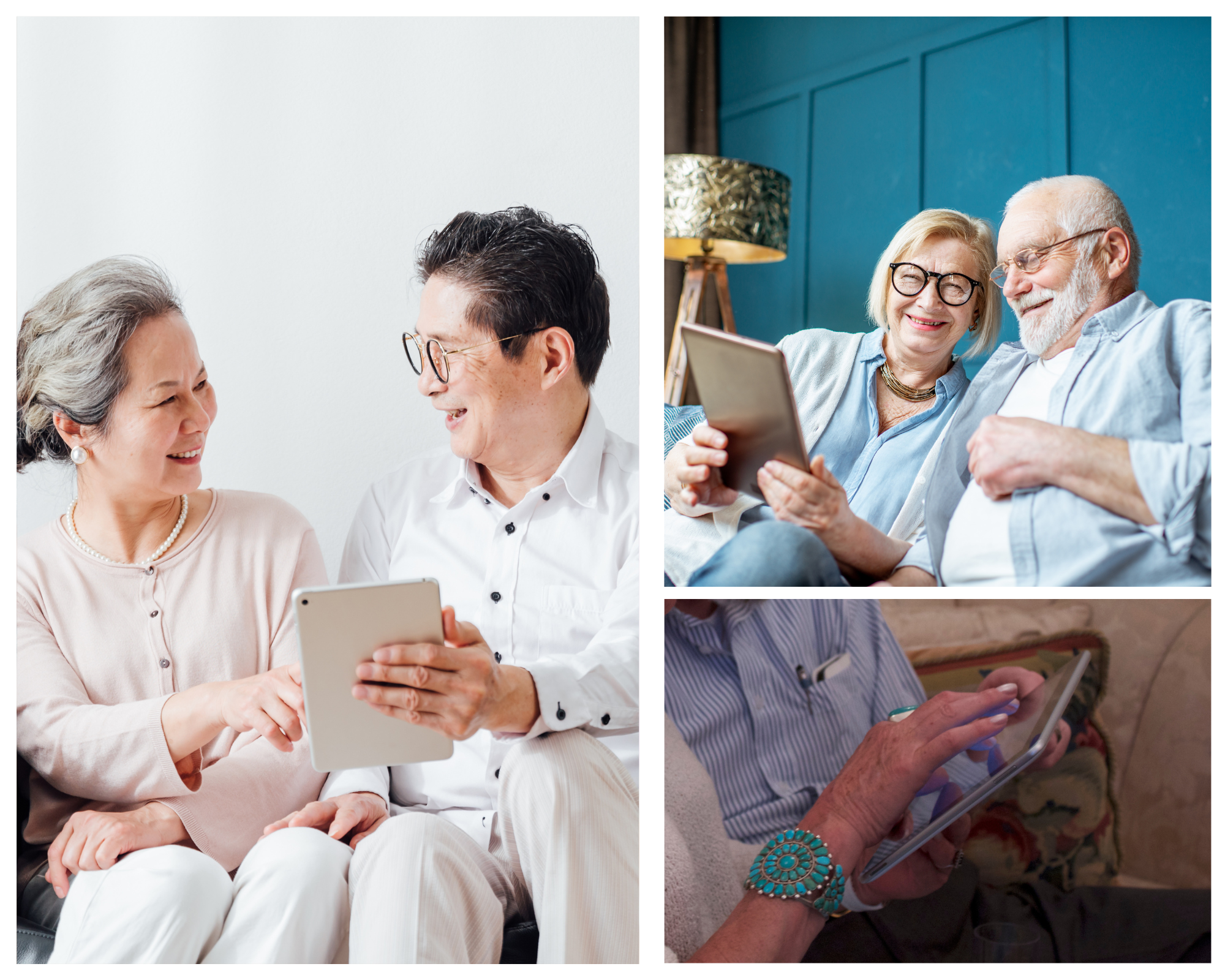
A Senior’s Guide to Getting Comfortable with Your iPad
October 24, 2023A Senior’s Guide to Getting Comfortable with Your iPad
For years, the butt of the joke was that seniors don’t know how to use their technology. While it is true that many seniors struggle with the newer technological advancements, more seniors than ever are using technology thanks to the global pandemic, and one device in particular has grown quite popular. According to a study by Pew Research, roughly one-third of seniors own a tablet, or iPad. This is a nearly 20% increase from 2013.
The chances are high that you have recently come into possession of an iPad of your own, or that you’re thinking of purchasing one yourself. While the prospect is exciting, learning a new device can also be quite overwhelming. If you’re looking for a senior’s guide to getting comfortable with your iPad, start here.
Why are iPads so great for seniors?
While there is something to be said about the practicality of a smartphone (namely the size and transportability), iPads are the preferred device for many seniors. Perhaps one of the driving forces for their popularity is the size of the screen. Many seniors struggle with eye strain and other eye-related issues that can make using a smartphone difficult, let alone reading a physical newspaper or book. The iPad’s larger screen allows any text to be as large as necessary.
With the screen size comes ease of access to just about everything a senior needs. From books, to television shows, to brain games, seniors can have their favorite source of entertainment at their fingertips. Messaging loved ones and utilizing apps such as FaceTime is also far easier on the iPad.
If you ever have to handle larger online documents, but don’t want to have a computer on top of your other devices, their iPad can act as a stand-in. Wireless keyboards, and even docking stations, are available for purchase, so seniors can have the ease of a computer without buying one.
A senior’s guide to using an iPad
Opening your iPad’s box is exciting, but once all the paper and plastic is set aside, you likely have one thought: “What now?” If you don’t have a family member or friend on standby who can help you with learning how to use your iPad, there are plenty of resources you can utilize. Start here for the basics, then do further research as necessary.
First steps
When you first take your new iPad out of the box, there are a series of steps you have to follow in order to get it started. While the prompts are fairly easy to follow, knowing the steps ahead of time will help you feel comfortable.
- To start, press the home button (the large, circular button at the bottom) or slide the screen up from the bottom using your finger.
- Select your preferred language
- Select your country or region
Here, you have two options: “Quick Start” option or a “Manual Set Up.” Those who are a little more comfortable with technology could choose the manual setup to select the settings of their own choices. However, most seniors will likely feel more comfortable with the quick start option. From that point on, you will connect to Wi-Fi and move forward with setting your password.
If you’ve never had an Apple device, you will have to create an Apple ID. Think of this as an email of sorts that connects you to all your apps or purchases.
Opening your iPad
You can’t access your password if you don’t know how to open it! Thankfully, on new iPads, there are a number of ways you can open your device. It is device dependent, but these options will come up as you are setting up the device.
- Touch ID. Using the button on the bottom of your tablet, or one on the side, you scan your fingerprint. Your iPad will prompt you to place your finger on slightly different angles over the button so your fingerprint can be properly scanned. When this process is complete, all you have to do is touch the button to open your iPad.
- Face ID. With this option, all you have to do is look at your iPad to unlock it. To use, hold your device about 10-20 inches from your face, then move your head in a circle as prompted. This way, the Face ID sees several angles of your face so it can recognize you with more ease.
- Traditional passcode. If you’d rather skip the above options, you can always rely on your passcode. Make sure you write down your passcode in an easy-to-remember secondary location, just in case you forget it.
If you don’t want to worry about the risk of forgetting your pin, you can actually disable this feature. Go to settings, tap “passcode” then tap “turn passcode off.” This, however, is not usually recommended, as your passcode helps keep your iPad safe and secure.
How to increase the text size
To adjust your display and text size to fit your needs, go to settings, then “Accessibility”, then “Display & Text Size.” From that point on, you will find a menu with adjustable options, including, but not limited to:
- Larger text—turn on “Larger Accessibility Sizes,” then adjust with the slider.
- Bold text
- Button shapes
- On/off labels
- Reduce transparency
- Increase contrast
More resources for learning about your iPad
If you have more questions about your iPad, you don’t want to hop from resource to resource to find precisely what you’re looking for. Instead, try one of these guides.
- iPad Basics Full iPad Tutorial on YouTube. A completely free guide that is over an hour long.
- iPad for Seniors Skillshare Class. A comprehensive course taught by a lifelong teacher.
- iPad for Seniors by Gary Watts. For those who prefer written instructions, this book is a fantastic resource.
For help at home, consider home care
Technology can make your life so much easier, but there are still some things you need physical help with. That is where home care comes into play. If you think you would benefit from support with personal care, meal preparations, medication reminders, and so much more, call Home Care Powered by AUAF at 773-274-9262. We would be happy to help.
Articles:
-
How to Use FaceTime: a Senior’s Guide
March 20th, 2024 -
The Best Organic Cleaning Products for Caregivers
March 19th, 2024 -
Celebrating St. Patrick’s Day with Seniors
March 14th, 2024 -
Intellectual Activities for Seniors to Keep their Brains Stimulated
March 13th, 2024 -
Tips for Communicating with Seniors with Hearing Loss
March 12th, 2024 -
How to Learn a New Language as an Older Adult
March 7th, 2024 -
Foods that Support Bone Health in Seniors
March 6th, 2024 -
A Note to Our Staff for Caregiver Appreciation Day
March 1st, 2024 -
The Importance of a Senior/Caregiver Bond
February 21st, 2024 -
Recreational Sports as Fitness for Seniors
February 27th, 2024 -
Exploring the Wonders of Reminiscence Therapy
February 15th, 2024 -
Staying Educated on Alzheimer’s Disease and Dementia Care
February 14th, 2024
Call Now! 773.274.9262






